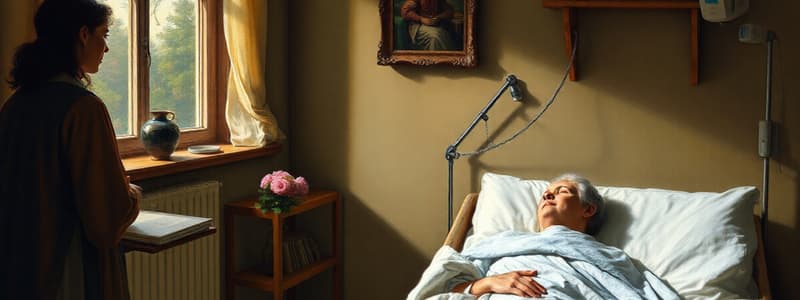Podcast
Questions and Answers
Welche der folgenden Personen gilt als eine der Hauptfiguren in der Entwicklung der modernen Hospizbewegung?
Welche der folgenden Personen gilt als eine der Hauptfiguren in der Entwicklung der modernen Hospizbewegung?
- Florence Nightingale
- Marie Curie
- Rosalind Franklin
- Cicely Saunders (correct)
In welchem Jahrzehnt begann die Hospizarbeit in Österreich?
In welchem Jahrzehnt begann die Hospizarbeit in Österreich?
- In den 1990er Jahren
- In den 1970er Jahren (correct)
- In den 1960er Jahren
- In den 1980er Jahren
Welches Jahr markiert die gesetzliche Verankerung der Palliativmedizin in Österreich?
Welches Jahr markiert die gesetzliche Verankerung der Palliativmedizin in Österreich?
- 1999 (correct)
- 2002
- 1993
- 2007
Welches Ziel wird in stationären Hospizen NICHT verfolgt?
Welches Ziel wird in stationären Hospizen NICHT verfolgt?
Welche Aussage trifft NICHT auf Palliativstationen zu?
Welche Aussage trifft NICHT auf Palliativstationen zu?
Welche Art der Zusammenarbeit im Gesundheitswesen beschreibt, dass verschiedene Berufe parallel nebeneinander arbeiten?
Welche Art der Zusammenarbeit im Gesundheitswesen beschreibt, dass verschiedene Berufe parallel nebeneinander arbeiten?
Die Verleugnung als erste der fünf Sterbephasen nach Kübler-Ross dient primär welchem Zweck?
Die Verleugnung als erste der fünf Sterbephasen nach Kübler-Ross dient primär welchem Zweck?
Welche Emotionen stehen typischerweise im Vordergrund der zweiten Sterbephase (Zorn) nach Kübler-Ross?
Welche Emotionen stehen typischerweise im Vordergrund der zweiten Sterbephase (Zorn) nach Kübler-Ross?
Was ist das Hauptmerkmal der Terminalphase?
Was ist das Hauptmerkmal der Terminalphase?
Welche Aussage beschreibt am besten das Vorgehen, wenn Angehörige einen Sterbenden zum Essen oder Trinken drängen wollen?
Welche Aussage beschreibt am besten das Vorgehen, wenn Angehörige einen Sterbenden zum Essen oder Trinken drängen wollen?
Was ist die korrekte Definition von 'Xerostomie'?
Was ist die korrekte Definition von 'Xerostomie'?
Welche der folgenden Ursachen kann Xerostomie begünstigen?
Welche der folgenden Ursachen kann Xerostomie begünstigen?
Was ist ein charakteristisches Merkmal chronischer Schmerzen im Vergleich zu akuten Schmerzen?
Was ist ein charakteristisches Merkmal chronischer Schmerzen im Vergleich zu akuten Schmerzen?
Welche Dimension von Schmerz bezieht sich auf die Gedanken und Überzeugungen, die ein Patient mit seinem Schmerz verbindet?
Welche Dimension von Schmerz bezieht sich auf die Gedanken und Überzeugungen, die ein Patient mit seinem Schmerz verbindet?
Was ist das Hauptziel des Stufenschemas der WHO zur Schmerzbehandlung?
Was ist das Hauptziel des Stufenschemas der WHO zur Schmerzbehandlung?
In welcher Stufe des WHO-Schemas zur Schmerzbehandlung werden schwache Opioide wie Codein oder Tramadol eingesetzt?
In welcher Stufe des WHO-Schemas zur Schmerzbehandlung werden schwache Opioide wie Codein oder Tramadol eingesetzt?
Was sollte bei der pflegerischen Versorgung nach Eintritt des Todes beachtet werden?
Was sollte bei der pflegerischen Versorgung nach Eintritt des Todes beachtet werden?
Welches der folgenden ist ein sicheres Todeszeichen?
Welches der folgenden ist ein sicheres Todeszeichen?
Welches Kriterium beschreibt Palliative Care laut WHO?
Welches Kriterium beschreibt Palliative Care laut WHO?
Was ist ein zentrales Ziel der Palliativversorgung?
Was ist ein zentrales Ziel der Palliativversorgung?
Was kennzeichnet Kachexie im Kontext der Palliativpflege am besten?
Was kennzeichnet Kachexie im Kontext der Palliativpflege am besten?
Welche Ursache kann NICHT zu Obstipation bei Palliativpatienten führen?
Welche Ursache kann NICHT zu Obstipation bei Palliativpatienten führen?
Was ist die treffendste Definition von Dyspnoe?
Was ist die treffendste Definition von Dyspnoe?
Was ist Death Rattle (Todesrasseln)?
Was ist Death Rattle (Todesrasseln)?
Welche Lagerung wird bei Übelkeit und Erbrechen in der Palliativpflege empfohlen?
Welche Lagerung wird bei Übelkeit und Erbrechen in der Palliativpflege empfohlen?
Flashcards
Pioniere der Hospizbewegung
Pioniere der Hospizbewegung
Cicely Saunders und Elisabeth Kübler-Ross initiierten moderne Hospizbewegung.
Stationäre Hospize
Stationäre Hospize
Stationäre Einrichtungen mit medizinischer, pflegerischer und psychosozialer Betreuung für komplexe Fälle.
Palliativstationen
Palliativstationen
Interdisziplinäre Stationen in Krankenhäusern zur Linderung belastender Symptome und Verbesserung der Lebensqualität.
Tageshospize
Tageshospize
Signup and view all the flashcards
Multiprofessionell
Multiprofessionell
Signup and view all the flashcards
Interprofessionell
Interprofessionell
Signup and view all the flashcards
Uniprofessionell
Uniprofessionell
Signup and view all the flashcards
Transprofessionell
Transprofessionell
Signup and view all the flashcards
Palliative-Care-Team
Palliative-Care-Team
Signup and view all the flashcards
5 Sterbephasen (Kübler-Ross)
5 Sterbephasen (Kübler-Ross)
Signup and view all the flashcards
Terminalphase
Terminalphase
Signup and view all the flashcards
Symptome der Terminalphase
Symptome der Terminalphase
Signup and view all the flashcards
Ziele in der Terminalphase
Ziele in der Terminalphase
Signup and view all the flashcards
Patientenrechte
Patientenrechte
Signup and view all the flashcards
Körperliche Bedürfnisse Sterbender
Körperliche Bedürfnisse Sterbender
Signup and view all the flashcards
Bedürfnisse Sterbender (Sinne)
Bedürfnisse Sterbender (Sinne)
Signup and view all the flashcards
Fatigue
Fatigue
Signup and view all the flashcards
Ursachen von Fatigue
Ursachen von Fatigue
Signup and view all the flashcards
Therapeutische Maßnahmen bei Fatigue
Therapeutische Maßnahmen bei Fatigue
Signup and view all the flashcards
Terminale Dehydration
Terminale Dehydration
Signup and view all the flashcards
Pflege bei terminaler Dehydration
Pflege bei terminaler Dehydration
Signup and view all the flashcards
Xerostomie
Xerostomie
Signup and view all the flashcards
Ursachen von Xerostomie
Ursachen von Xerostomie
Signup and view all the flashcards
Akute vs. chronische Schmerzen
Akute vs. chronische Schmerzen
Signup and view all the flashcards
WHO-Stufenschema (Schmerz)
WHO-Stufenschema (Schmerz)
Signup and view all the flashcards
Study Notes
- Modern hospice care is rooted in the work of Cicely Saunders, founder of St. Christopher's Hospice in 1967, and Elisabeth Kübler-Ross, known for her 5 stages of grief in 1969.
- Hospice care started in Austria in the late 1970s, spearheaded by Sr. Hildegard Teuschl from 1985.
- Key milestones in Austria included the establishment of Hospiz Österreich in 1993, the legal establishment of palliative medicine in 1999, and the introduction of family hospice leave in 2002, leading to a comprehensive hospice and palliative care system.
Forms of palliative care organizations
- Stationary Hospices: Independent organizational set-up or affiliated with nursing facilities.
- Goals: Symptom management, relief and stabilization, and discharge to home when possible.
- Provides place of death with medical, nursing, and psychosocial care.
- Target group: Adult palliative patients with complex symptoms requiring high levels of care.
- Palliative Care Units: Independent or integrated into a hospital.
- Multidisciplinary basis.
- Goals: Symptom relief, improved quality of life.
- Discharge is a goal.
- Target group: Palliative patients of all ages with complex medical, nursing, or psychosocial symptoms needing intensive care.
- Limitations: Reimbursement pressures (LKF), limited stay to 3 weeks.
- Day Hospices:
- Goal: Optimal relief and support so patients can stay at home.
- Tasks: Palliative medical, nursing, and psychosocial care by a multidisciplinary team.
- Target group: Mobile palliative patients who want to sleep at home.
Types of Collaboration in Palliative Care
- Multiprofessional: Various professions working parallel to each other.
- Interprofessional: Different professions closely collaborate.
- Uniprofessional: Collaboration within a single profession, like doctors or nurses.
- Transprofessional: Blurred professional boundaries, tasks flexibly distributed based on individual skills, common in modern care models.
- Common goal for all professions: to ensure optimal care, support, and quality of life for patients or clients.
Goals of Palliative Care
- Alleviation of pain and other burdensome symptoms.
- Psychosocial and spiritual support for patients and families.
- Promotion of patient autonomy and dignity.
- Support during the end-of-life phase.
Professions in a Palliative Careteam
- The team comprises various professions working closely together:
- Physicians (palliative specialists, oncologists, general practitioners): Medical care, pain therapy.
- Nurses (palliative care, hospice care): Symptom control, physical and emotional care.
- Physical therapists: Improving mobility, reducing pain.
- Psychologists/Psychotherapists: Psychological support, bereavement counseling.
- Social workers: Assistance with social and legal issues.
- Chaplains (spiritual advisors): Spiritual support, regardless of religious affiliation.
- Occupational therapists: Promoting independence in daily life.
- Volunteers: Support for patients and families.
- Close interprofessional collaboration facilitates comprehensive care, addressing physical, psychological, social, and spiritual needs.
Elisabeth Kübler-Ross's Five Stages of Grief
- Stage 1: Denial
- The person refuses to accept the reality of their diagnosis or impending mortality.
- Statements like "This can't be happening" or "The doctors must be wrong" are common.
- Denial serves as a temporary defense mechanism against the harsh truth.
- Stage 2: Anger
- Reality becomes undeniable, often leading to anger directed at doctors, loved ones, or fate.
- Patients question "Why me?" or express feelings of unfairness.
- This stage can be challenging for those around the dying person, as they may become the target of displaced anger.
- Underlying emotions are fear and helplessness.
- Empathy and patience are crucial.
- Stage 3: Bargaining
- The person attempts to negotiate with doctors, God, or destiny to gain more time.
- Thoughts like "If I live another year, I'll be a better person" or "I'll do anything to see my grandchildren grow up" are typical.
- This stage represents a form of hope, trying to avert the inevitable.
- Some patients may seek alternative treatments or religious practices.
- Stage 4: Depression
- The individual acknowledges that death is inescapable, leading to sadness and hopelessness.
- Feelings like fear, despair, and loneliness emerge.
- Some withdraw, lose interest in life, or become less talkative.
- Family members should offer support without trying to minimize the pain or force positivity.
- Stage 5: Acceptance
- The dying person comes to terms with their situation and finds peace.
- There are fewer intense emotions like anger or sadness, replaced by a sense of calm.
- Focus often shifts to saying goodbye and cherishing final moments with loved ones.
- Family members also go through these stages, but on a different timeline.
Terminal Phase
- The terminal phase is the final stage of life, typically encompassing the last days or weeks before death.
Terminal Phase Symptoms
- General weakness and confinement to bed: The person has little energy, sleeps often, and has limited mobility.
- Reduced food and fluid intake: Hunger decreases, and the body requires less sustenance.
- Caregivers should not pressure the person to eat or drink, as reduced intake is a natural part of the dying process.
- Changes in consciousness: Increasing drowsiness, slowed responses, or unresponsiveness.
- Periods of confusion or agitation may occur.
- Altered breathing patterns (end-of-life breathing): Irregular breathing with long pauses (Cheyne-Stokes respiration).
- Noisy breathing due to mucus accumulation in the airways.
- Drop in blood pressure and altered circulation: Cold, bluish hands and feet.
- Pale or mottled skin.
- Changes in elimination: Decreased urine production with darker urine.
- Possible loss of bladder and bowel control.
- Inner restlessness or withdrawal: Some individuals become restless in their final hours or days (terminal delirium).
- Others withdraw and cease communication.
- Goals of care during the terminal phase: Symptom relief like pain management and breathing ease etc
- Emotional support through presence, soothing words, and touch.
- Dignified end-of-life care: Allowing the dying person to pass at their own pace without being pressured. Patients have the right to honest and understandable information about their diagnosis, prognosis, and available treatment options.
Physical needs of the Dying
- Adjust fluid and nutrition as needed.
- Provide increased rest.
- Assist with elimination.
- Pay attention to how temperature is perceived.
Sensory perception changes
- Impaired vision: Reduced eyesight, narrow field of vision, blurry images.
- Provide calming lighting, familiar items in view.
- Hearing: Often remains intact until the end.
- Speak gently, calmly, offer soothing music or familiar voices.
- Touch: Can become more sensitive or dulled.
- Offer gentle touch, soft clothes and bedding.
- Smell: Can become more sensitive.
- Provide fresh air, gentle aromas, and avoid harsh smells. Taste: Diminished or altered. -Moisten lips and mouth.
Symptom of Fatigue
- Fatigue is an extreme, persistent exhaustion not relieved by rest, affecting both body and mind.
- Symptoms include severe physical and mental exhaustion, reduced performance, focus and memory problems, lack of motivation, irritation, and depressive moods.
- Causes are Illness, cancer, infections and organ related issues and therapy, chemotherapy, radiation, or medications.
- Psychological reasons are Anxiety, depression, stress, or social isolation
- Physiological reasons are Anemia or hormone related issues or Dehydration
Measures to alleviate Fatigue
- Physical measures such as Exercise that is customized and rest, but not full inactivity. Diet should be balanced to support energy.
- Treatments - Treat anemia or hormone problem. Adjust pain killers.
- Emotional - Therapy and Meditation
- Fatigue is a prevalent symptom, with a combination of things patients can feel better.
Terminal Dehydration
- Terminal dehydration is fluid- short falls at days end, as its dying.
- Body naturally adjusts and causes a peaceful, relaxed passing.
- Also lessens pulmonary issues and fluid build up
- Negative issue and remedy - feeling dry, need to maintain mouth. Delirium that needs meds. Or psychological stress from need to give water.
- To remedy the mouth feels better with great oral and skin care!
Xerostomia
- Xerostomia - mouth feels dry that is caused by decrease of spit.
- Meds- antidepressant, antihistamines pain or BP regulation
- Health Syndromes such as autoimmune and diabetes
- Cancer Treatment
- Lack of Fluids and old age
- Care - oral care, hydration and change in diet
Types of Pain
- Chronic pain is long term
- Physical, Emotional, Cognitive, Social Spiritual, Behavioral
- Rate of pain can determine treatment
Who pain management steps
- Step one has non-opioid like narcotics (Tylenol) or ibuprofen. Use external measure to soothe
- Step two has mild opioid (codeine or tramadol
- Step three has stronger opioid medications(morphine
Post Mortem steps
- Get rid of med devices. But don’t move drains. Wash the body.
- Add dentures, if needed and place a cloth on eyes to shut them
- Place a cloth under the chin, allow for needs from lost, fix room to seem tidy
Signs of Life ending
- Clinical end comes 3 minutes after heart failures
- Brain end is total failures
- Signs are - Permanent end of breath, loss of breath, brain test, rigor mortis
Criteria for Palliative Care by WHO
- Palliative should focus on patient with life hurtling conditions. Can be put with other meds. Should be from team and control of life, families, ethically and with auto. Main goal of Care - alleviate pain, support family and increase quality of life and keep auto
Cachexia
- Cachexia - is a sickness from too much weight lost and weakening. Chronic health conditions and cancer are a reason, with metabolic or physical problems.
- What helps : Nutritional help, easy meals, great environment, and symptom control
- Help feel better from pains or bad mouth and have therapy and monitoring
Obstipation
- Causes: Dehydration, lack of eats, meds, age problems
- Solution: Add fluid + food, get exercise, medicine help, therapy + monitor
Dyspnea
- Dyspnea - Hard time breathing or air hunger,
- Death Rattle - rattling when dying through lung issues
Nausea
- Nausea Reasons: Sick, meds, brain and psych problems
- Help: Comfort and change room, easy food and drink.
Help a dying person
- touch carefully and remember personal thought, do not do face and be gentle.
Pain meds
- Opioids : Oral, Sublingual, Transdermal, by Vein, by skin, by muscle
Sleep
- Sleep solution - dark area and comfy or rituals
- With no tv, caffeine, alchohol
Pruritus
- Pruritus or ick from skin! - Get creams, cool down and stay loose
Delirium
- Causes - pain and meds
- Help - easy rooms and low words. With safe support and therapy
Studying That Suits You
Use AI to generate personalized quizzes and flashcards to suit your learning preferences.




